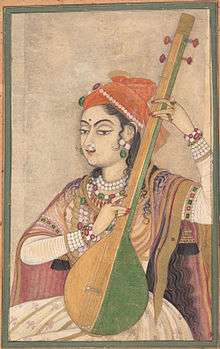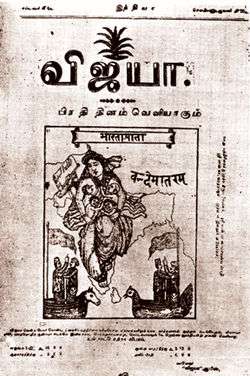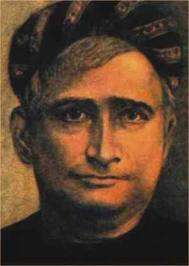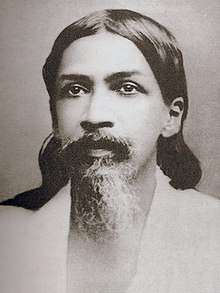Vande Mataram
'"Vande Mataram" (IAST: Vande Mātaram) (transl. Mother, I bow to thee) is a Sanskrit poem written by Bankim Chandra Chatterjee in 1870s, which he included in his 1882 Bengali novel Anandamath. The poem was first sung by Rabindranath Tagore in 1896.[1] The first two verses of the song were adopted as the National Song of India in October 1937 by the Congress Working Committee prior to the end of colonial rule in August 1947.[2][3][4]
| Vande Mataram | |
.png) Vande Mataram written by Bankim Chandra Chatterjee set to Raag Desh as performed on All India Radio | |
National song of India | |
| Lyrics | Bankim Chandra Chatterjee, Anandamath (1882) |
|---|---|
| Music | Hemanta Mukherjee, Jadunath Bhattacharya |
| Adopted | 24 January 1950 |
| Music of India | |
|---|---|
 A Lady Playing the Tanpura, c. 1735 (Rajasthan) | |
| Genres | |
| Traditional
Modern | |
| Media and performance | |
| Music awards | |
| Music festivals | |
| Music media | |
| Nationalistic and patriotic songs | |
| National anthem | Jana Gana Mana |
| Regional music | |
| |
An ode to the Motherland, it was written in Bengali script in the novel Anandmath.[5] The title 'Vande Mataram' means "I praise thee, Mother" or "I praise to thee, Mother".[1][6] The "mother goddess" in later verses of the song has been interpreted as the motherland of the people – Banga Mata (Mother Bengal) and Bharat Mata (Mother India),[7][8] though the text does not mention this explicitly.
It played a vital role in the Indian independence movement, first sung in a political context by Rabindranath Tagore at the 1896 session of the Indian National Congress.[9] It became a popular marching song for political activism and Indian freedom movement in 1905.[1] Spiritual Indian nationalist and philosopher Sri Aurobindo referred it as "National Anthem of Bengal".[10] The song and the novel containing it was banned by the British government, but workers and general public defied the ban, many went to colonial prisons repeatedly for singing it, and the ban was overturned by the Indians after they gained independence from the colonial rule.[11][12]
On 24 January 1950, the Constituent Assembly of India has adopted "Vande Mataram" as national song. On the occasion, the first President of India, Rajendra Prasad stated that the song should be honoured equally with the national anthem of India, "Jana Gana Mana".[13] However the Constitution of India does not have any mention of "national song".[14][15]
The first two verses of the song are an abstract reference to mother and motherland, they do not mention any Hindu deity by name, unlike later verses that do mention goddesses such as Durga.[16][17] There is no time limit or circumstantial specification for the rendition of this song unlike the national anthem "Jana Gana Mana" that specifies 52 seconds.[18]
Etymology
The root of the Sanskrit word Vande is Vand, which appears in Rigveda and other Vedic texts.[19][note 1] According to Monier Monier-Williams, depending on the context, vand means "to worship, to praise, celebrate, laud, extol, to show honour, do homage, salute respectfully", or "deferentially, venerate, worship, adore", or "to offer anything respectfully to".[19][20] The word Mātaram has Indo-European roots in mātár- (Sanskrit), méter (Greek), mâter (Latin) which mean "mother".[21][22]
Lyrics of the Song
The first two verses of Vande Mataram adopted as the "National Song" read as follows:
| Bengali script[23] | Bengali phonemic transcription | Devnagari script | IAST transliteration[9][24] |
|---|---|---|---|
বন্দে মাতরম্৷ |
Vônde matôrôm |
वन्दे मातरम्। |
vande mātaram |
Lyrics
The complete original lyrics of the Vande Mataram is available at – via Wikisource..

| বন্দে মাতরম্ (Bengali Script) | Latin transliteration (IAST) | वन्दे मातरम् (Devanagari transliteration) |
|---|---|---|
|
|
|
Translation

The first translation of Bankim Chandra Chattopadhyay's novel Anandamath, including the poem Vande Mataram, into English was by Nares Chandra Sen-Gupta, with the fifth edition published in 1906 titled "The Abbey of Bliss".[25]
Here is the translation in prose of the above two stanzas rendered by Sri Aurobindo Ghosh. This has also been adopted by the Government of India's national portal.[9] The original Vande Mataram consists of six stanzas and the translation in prose for the complete poem by Shri Aurobindo appeared in Karmayogin, 20 November 1909.[26]
Mother, I praise thee!
Rich with thy hurrying streams,
bright with orchard gleams,
Cool with thy winds of delight,
Dark fields waving Mother of might,
Mother free.
Glory of moonlight dreams,
Over thy branches and lordly streams,
Clad in thy blossoming trees,
Mother, giver of ease
Laughing low and sweet!
Mother I kiss thy feet,
Speaker sweet and low!
Mother, to thee I praise thee. [Verse 1]
Who hath said thou art weak in thy lands
When the swords flash out in seventy million hands
And seventy million voices roar
Thy dreadful name from shore to shore?
With many strengths who art mighty and stored,
To thee I call Mother and Lord!
Thou who savest, arise and save!
To her I cry who ever her foeman drove
Back from plain and Sea
And shook herself free. [Verse 2]
Thou art wisdom, thou art law,
Thou art heart, our soul, our breath
Thou art love divine, the awe
In our hearts that conquers death.
Thine the strength that nerves the arm,
Thine the beauty, thine the charm.
Every image made divine
In our temples is but thine. [Verse 3]
Thou art Durga, Lady and Queen,
With her hands that strike and her swords of sheen,
Thou art Lakshmi lotus-throned,
And the Muse a hundred-toned,
Pure and perfect without peer,
Mother lend thine ear,
Rich with thy hurrying streams,
Bright with thy orchard gleems,
Dark of hue O candid-fair [Verse 4]
In thy soul, with bejeweled hair
And thy glorious smile divine,
Loveliest of all earthly lands,
Showering wealth from well-stored hands!
Mother, mother mine!
Mother sweet, I praise thee,
Mother great and free! [Verse 5]


Apart from the above prose translation, Sri Aurobindo also translated Vande Mataram into a verse form known as Mother, I praise thee!.[27] Sri Aurobindo commented on his English translation of the poem that "It is difficult to translate the National Song of India into verse in another language owing to its unique union of sweetness, simple directness and high poetic force."[28]
Translation into other languages
Vande Mataram has inspired many Indian poets and has been translated into numerous Indian languages, such as Tamil, Telugu, Kannada, Malayalam, Assamese, Hindi, Marathi, Gujarati, Punjabi Urdu and others.[29][note 2]
Arif Mohammad Khan translated Vande Mataram in Urdu.[31] It can be read in Urdu (Devanagari script) as:
तस्लीमात, मां तस्लीमात
तू भरी है मीठे पानी से
फल फूलों की शादाबी से
दक्खिन की ठंडी हवाओं से
फसलों की सुहानी फिजाओं से
तस्लीमात, मां तस्लीमात
तेरी रातें रोशन चांद से
तेरी रौनक सब्ज-ए-फाम से
तेरी प्यार भरी मुस्कान है
तेरी मीठी बहुत जुबान है
तेरी बांहों में मेरी राहत है
तेरे कदमों में मेरी जन्नत है
तस्लीमात, मां तस्लीमात[32]
History and significance
Composition
Bankim Chandra Chatterjee was one of the earliest graduates of the newly established Calcutta University. After his BA, he joined the British Indian government as a civil servant, becoming a Deputy Collector and later a Deputy Magistrate. Chattopadhyay was very interested in recent events in Indian and Bengali history, particularly the Revolt of 1857 and the previous century's Sanyasi Rebellion.[33] Around the same time, the administration was trying to promote "God Save the Queen" as the anthem for Indian subjects, which Indian nationalists disliked. It is generally believed that the concept of Vande Mataram came to Bankim Chandra Chattopadhyay when he was still a government official, around 1876.[34] He wrote Vande Mataram at Chinsura(Chuchura), there is a white colour house of Adhya Family near river Hooghly (near Mallik Ghat).
Chattopadhyay wrote the poem in a spontaneous session using words from Sanskrit and Bengali. The poem was published in Chattopadhyay's book Anandamath (pronounced Anondomôţh in Bengali) in 1882, which is set in the events of the Sannyasi Rebellion.[33][34] Jadunath Bhattacharya was asked to set a tune for this poem just after it was written.[34]
Indian independence movement
.svg.png)
"Vande Mataram" was one of the most popular songs of protest [against British rule] during the Indian independence movement.The British, in response banned the book and made the recital of the song a crime.[11] The British colonial government imprisoned many independence activists for disobeying the order, but workers and general public repeatedly violated the ban many times by gathering together before British officials and singing it.[11] Rabindranath Tagore sang Vande Mataram in 1896 at the Calcutta Congress Session held at Beadon Square. Dakhina Charan Sen sang it five years later in 1901 at another session of the Congress at Calcutta. Poet Sarala Devi Chaudurani sang the song in the Benares Congress Session in 1905. Lala Lajpat Rai started a journal called Vande Mataram from Lahore.[34] Hiralal Sen made India's first political film in 1905 which ended with the chant. Matangini Hazra's last words as she was shot to death by the Crown police were Vande Mataram.[35]

In 1907, Bhikaiji Cama (1861–1936) created the first version of India's national flag (the Tiranga) in Stuttgart, Germany, in 1907. It had Vande Mataram written on it in the middle band.[36]
A book titled Kranti Geetanjali published by Arya Printing Press (Lahore) and Bharatiya Press (Dehradun) in 1929 contains first two stanzas of this lyric on page 11[37] as Matra Vandana and a ghazal (Vande Mataram) composed by Bismil was also given on its back, i.e. page 12.[38] The book written by the famous martyr of Kakori Pandit Ram Prasad Bismil was proscribed by the then British government of India.
Mahatama Gandhi supported adoption and the singing of the Vande Mataram song. In January 1946, in a speech in Guwahati (Assam), he urged that "Jai Hind should not replace Vande-mataram". He reminded everyone present that Vande-mataram was being sung since the inception of the Congress. He supported the "Jai Hind" greeting, but remanded that this greeting should not be to the exclusion of Vande Mataram. Gandhi was concerned that those who discarded Vande Mataram given the tradition of sacrifice behind it, one day would discard “Jai Hind” also.[39][note 3]
Debate on adoption as national song of India
Parts of the Vande Mataram was chosen as the national song in 1937 by the Indian National Congress as it pursued independence of India from the British colonial rule, after a committee consisting of Maulana Azad, Jawaharlal Nehru, Subhash Bose, Acharya Deva and Rabrindanath Tagore recommended the adoption.[41] The entire song was not selected by Hindu leaders in order to respect the sentiments of non-Hindus, and the gathering agreed that anyone should be free to sing an alternate "unobjectionable song" at a national gathering if they do not want to sing Vande Mataram because they find it "objectionable" for a personal reason.[41] According to the gathered leaders, including the Nobel Laureate Rabindranath Tagore, though the first two stanzas began with an unexceptionable evocation of the beauty of the motherland, in later stanzas there are references to the Hindu goddess Durga. The Muslim League and Muhammad Ali Jinnah opposed the song. Thereafter, with the support of Mahatma Gandhi and Jawahar Lal Nehru, the Indian National Congress decided to adopt only the first two stanzas as the national song to be sung at public gatherings, and other verses that included references to Durga and Lakshmi were expunged.[2][42]
Rajendra Prasad, who was presiding the Constituent Assembly on 24 January 1950, made the following statement which was also adopted as the final decision on the issue:
...The composition consisting of the words and music known as Jana Gana Mana is the National Anthem of India, subject to such alterations in the words as the Government may authorise as occasion arises; and the song Vande Mataram, which has played a historic part in the struggle for Indian freedom, shall be honoured equally with Jana Gana Mana and shall have equal status with it. (Applause). I hope this will satisfy the Members.
- —Constituent Assembly of India, Vol. XII, 24-1-1950[43]
Performances and interpretations
The poem has been set to a large number of tunes. The oldest surviving audio recordings date to 1907, and there have been more than a hundred different versions recorded throughout the 20th century. Many of these versions have employed traditional South Asian classical ragas. Versions of the song have been visualised on celluloid in a number of films, including Leader, Amar Asha, and Anand Math. It is widely believed that the tune set for All India Radio station version was composed by Ravi Shankar.[34] Hemant Kumar composed music for the song in the movie Anand Math in 1952 Many singers like Lata Mangeshkar , K.S.Chithra sung made it cult classic.[44] In 2002, BBC World Service conducted an international poll to choose ten most famous songs of all time. Around 7000 songs were selected from all over the world. Vande Mataram, from the movie Anand Math, was ranked second.[45] All India Radio's version and some other versions are in Desh raga.[46]
In July 2017, the Madras High Court ruled that the Vande Mataram shall be sung or played at least once a week in all schools, universities and other educational institutions of Tamil Nadu. The Court also ruled that the song should be played or sung in government offices and industrial facilities at least once a month.[47]
See also
- Anandmath— The novel from which "Vande Mataram" gained popularity
- "Jana Gana Mana"- The Indian national anthem
- "Saare Jahan Se Achcha"
- "Subh Sukh Chain"
- Banga Mata
- Bharat Mata
- Tamil Thai
- Telugu Thalli
- Telangana Thalli
- Bharat Mata Ki Jai
- Vande Mataram (album)
- National Pledge
- List of Indian state anthems
Notes
- sometimes transcribed as ধর্ম
- sometimes transcribed as মর্ম
- Sanskrit transliteration "Vande"
- Sanskrit transliteration "varadāṃ"
- Sanskrit transliteration "Dvisaptakoṭībhujaidhṛtakharakaravāle"
- Sanskrit transliteration "Avalā"
- Sanskrit transliteration "vale"
- Sanskrit transliteration "Vahuvaladhārinīṃ"
- Sanskrit transliteration "Ripudalavārinī"
- Sanskrit transliteration "vidyā"
- Sanskrit transliteration "Tvaṃ"
- Sanskrit transliteration "Vāhute"
- Sanskrit transliteration "Tvaṃ"
- Sanskrit transliteration "Vānī"
- Sanskrit transliteration "vidyādāẏinī"
- Sanskrit transliteration "tvaṃ"
- Sanskrit transliteration "Vande"
- See, for example, Rigveda 1.27.1; Sanskrit: अश्वं न त्वा वारवन्तं वन्दध्या अग्निं नमोभिः । सम्राजन्तमध्वराणाम् ॥१॥ Wikisource
- The Assamese version, re-translated into English, reads:[30]
"O my own land,
O my dear land,
O my dear land,
A land bedecked with gentle streams,
A land that adorned with heavenly beauty,
It is such a motherland." – Lakshminath Bezbarua, Translated into English by A Mazumdar - This view of Gandhi was not isolated. In another interview, he said, "a song that carried such glorious associations of sacrifice as “Vandemataram” could never be given up. It would be like discarding one’s mother. But they could certainly add a new song or songs like the one mentioned to their repertoire of national songs after due thought and discrimination."[40]
References
- Diana L. Eck (2012). India: A Sacred Geography. New York: Random House (Harmony Books). pp. 95–97. ISBN 978-0-385-53190-0.
- The National Flag Archived 16 March 2015 at the Wayback Machine, The Collected Works of Mahatma Gandhi, Volume 76, June 27, 1939, pages 68–70 with footnote 1 on page 69
- Sabyasachi Bhattacharya (2003). Bande Mataram, the Biography of a Song. Penguin Books. pp. 17–24. ISBN 978-0-14-303055-3.
- S. K. BOSE (2015). Bankim Chandra Chatterji. Publications Division Ministry of Information & Broadcasting. pp. 88–92. ISBN 978-81-230-2269-7.
- Sabyasachi Bhattacharya (2003). Bande Mataram, the Biography of a Song. Penguin. pp. 1–8, 73–76, 90–99. ISBN 978-0-14-303055-3.
- Ghose, Aurbindo. "National Song". Know India. Government of India. Archived from the original on 15 January 2013. Retrieved 12 November 2016.
- Sabyasachi Bhattacharya (2003). Bande Mataram, the Biography of a Song. Penguin. pp. 68–77, 26–29. ISBN 978-0-14-303055-3.
- Sumathi Ramaswamy (2009). The Goddess and the Nation: Mapping Mother India. Duke University Press. pp. 106–108. ISBN 978-0-8223-9153-1.
- "National Song of India". Government of India. Archived from the original on 15 January 2013. Retrieved 29 April 2008.
- Sri Aurobindo commented on his English translation of the poem with "It is difficult to translate the National Anthem of Bengal into verse in another language owing to its unique union of sweetness, simple directness and high poetic force." cited after Bhabatosh Chatterjee (ed.), Bankim Chandra Chatterjee: Essays in Perspective, Sahitya Akademi, Delhi, 1994, p. 601.
- Bankimcandra Chatterji (2005). Anandamath, or The Sacred Brotherhood. Oxford University Press. pp. 71–78. ISBN 978-0-19-803971-6.
- Aurobindo Mazumdar (2007). Bande Mataram and Islam. Mittal Publications. pp. 18–22, 30–31. ISBN 978-81-8324-159-5.
- "National Symbols | National Portal of India". Retrieved 23 January 2020.
- "HC dismisses plea to declare 'Vande Mataram' as national anthem or song". The Indian Express. 27 July 2019. Retrieved 1 November 2019.
- "No concept of National Song in Constitution, says SC". Hindustan Times. 17 February 2017. Retrieved 1 November 2019.
- Sabyasachi Bhattacharya (2003). Bande Mataram, the Biography of a Song. Penguin Books. pp. 34–37, 81. ISBN 978-0-14-303055-3.
- Sumathi Ramaswamy (2009). The Goddess and the Nation: Mapping Mother India. Duke University Press. pp. 125–142. ISBN 978-0-8223-9153-1.
- "No rules on singing, playing of 'Bande Mataram': Government – Times of India". The Times of India. Archived from the original on 12 February 2017. Retrieved 12 February 2017.
- Monier Monier-Williams, English Sanskrit Dictionary with Etymology Archived 28 April 2017 at the Wayback Machine, Oxford University Press, page 919
- Bankimcandra Chatterji (2005). Anandamath, or The Sacred Brotherhood. Oxford University Press. p. 244. ISBN 978-0-19-534633-6.
- Edward Bispham (2010). Edinburgh Companion to Ancient Greece and Rome. Edinburgh University Press. p. 32. ISBN 978-0-7486-2714-1.
- J. P. Mallory; Douglas Q. Adams (1997). Encyclopedia of Indo-European Culture. Taylor & Francis. pp. 385–386. ISBN 978-1-884964-98-5.
- "Vande Mataram in Bengali script". Archived from the original on 2 October 2011. Retrieved 1 August 2011.
- "Vande Mataram in Romanized Sanskrit". Archived from the original on 2 October 2011. Retrieved 31 July 2011.
- Bankimcandra Chatterji (23 August 2005). Anandamath, or The Sacred Brotherhood. Oxford University Press. pp. 44–. ISBN 978-0-19-534633-6.
- Aurobindo Mazumdar (2007). Vande Mataram and Islam. Mittal Publications. pp. 4–6. ISBN 978-81-8324-159-5.
- "Sri Aurobindo's VERSE translation of Vande Mataram". Archived from the original on 27 September 2011. Retrieved 31 July 2011.
- Bhabatosh Chatterjee (ed.), Bankim Chandra Chatterjee: Essays in Perspective, Sahitya Akademi, Delhi, 1994, p. 601.
- Aurobindo Mazumdar (2007). Vande Mataram and Islam. Mittal Publications. pp. 23–34. ISBN 978-81-8324-159-5.
- Aurobindo Mazumdar (2007). Vande Mataram and Islam. Mittal Publications. pp. 26–27. ISBN 978-81-8324-159-5.
- "Unnecessary And Irrelevant". Outlook India. Retrieved 30 December 2019.
- "केरल के गवर्नर बने आरिफ मोहम्मद खान, पढ़ें वंदे मातरम का उर्दू में उनका अनुवाद". Navbharat Times (in Hindi). Retrieved 30 December 2019.
- Lipner, Julius (2005). Anandamath. Oxford, UK: Oxford University Press. pp. 27–59. ISBN 978-0-19-517858-6.
- Suresh Chandvankar, Vande Mataram Archived 29 August 2006 at the Wayback Machine (2003) at Musical Traditions (mustrad.org.uk)
- Chakrabarty, Bidyut (1997). Local Politics and Indian Nationalism: Midnapur (1919–1944). New Delhi: Manohar. p. 167.
- "p2". Archived from the original on 6 March 2016. Retrieved 8 February 2016.
- Kranti Geetanjali (Poems of Pt. Ram Prasad 'Bismil'), ISBN 81-7783-128-3.
-
- Kranti Geetanjali ISBN 81-7783-128-3.
- Speech at Prayer Meeting (Guwahati, Assam) Archived 16 March 2015 at the Wayback Machine, The Collected Works of Mahatma Gandhi, January 10, 1946, page 212
- Discussion with Political Workers Archived 16 March 2015 at the Wayback Machine, The Collected Works of Mahatma Gandhi, 1945, page 89
- A. G. Noorani (1973), Vande Mataram: A Historical Lesson Archived 21 February 2017 at the Wayback Machine, EPW, Vol. 8, No. 23 (Jun. 9, 1973), pages 1039–1043
- Marie Cruz Gabriel (1996). A Silence in the City and Other Stories. Orient Blackswan. pp. 238–240. ISBN 978-81-250-0828-6.
- "Constituent Assembly of India Debates".
- Pradeep Kumar Archived 3 March 2016 at the Wayback Machine Rediff.com.
- The Worlds Top Ten Archived 21 August 2006 at the Wayback Machine — BBC World Service
- "Des: Tunes from the Countryside". Archived from the original on 3 March 2016. Retrieved 31 May 2011.
- Madras High Court makes Vande Mataram mandatory in schools and colleges Archived 28 July 2017 at the Wayback Machine, India Today (July 25, 2017)
- Sabyasachi Bhattacharya, Vande Mataram: The Biography of a Song, Penguin Books, 2003, ISBN 978-0-14-303055-3.
Further reading
- Tagore, Sir Rabindranath (1919) [1916]. The Home and the World. Trans. from Bengali by Surendranath Tagore. London: MacMillan & Co. OCLC 228705970. Bande (with a B rather than a V) Mataram plays a great part in this novel about a Bengali family.
- "Vande Mataram : Biography of a Song" by Sabyasachi Bhattacharya, Publisher:Penguin, ISBN 9780143030553
External links
| Wikiquote has quotations related to: Vande Mataram |
| Wikisource has original text related to this article: |
Vocals
- Vande Mataram, Lata Mangeshkar in Anand Math (4:57 minutes)
- Vande Mataram, Amruta Suresh and Abhirami Suresh (4:36 minutes)
- Vande Mataram, Group song (1:09 minutes)
Debate
- "National Song" section, Official Portal of the Indian Government
- How Secular is Vande Mataram?, AG Noorani, Frontline
- Boycott threat over Indian song, BBC
- 1937 Congress Resolution on validity of Muslim objection to this song, Outlook India

